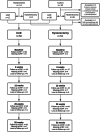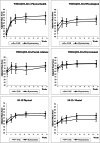Quality of life 1 year after uterine artery embolization vs hysterectomy for symptomatic adenomyosis (QUESTA study)
- PMID: 40420328
- PMCID: PMC12283165
- DOI: 10.1111/aogs.15165
Quality of life 1 year after uterine artery embolization vs hysterectomy for symptomatic adenomyosis (QUESTA study)
Abstract
Introduction: Uterine artery embolization (UAE) is a less-invasive alternative for hysterectomy in therapy-resistant symptomatic adenomyosis. Comparative data are lacking. Our objective is to evaluate the non-inferiority of UAE compared with hysterectomy in improving health-related quality of life (HRQOL) for symptomatic adenomyosis, 1 year post-treatment.
Material and methods: This multicenter randomized controlled trial was converted into a prospective cohort study. It was prospectively registered at 27-07-2015 (NL-OMON55436, https://onderzoekmetmensen.nl/en/trial/55436). From November 2015 to March 2022 participants with symptomatic adenomyosis eligible for hysterectomy were included and offered UAE as an alternative treatment. Primary endpoint was difference in 1-year HRQOL scores between UAE and hysterectomy, using WHO-QOL-Bref and SF-12. Non-inferiority margin was set at five points. Secondary endpoints: WHO-QOL-100 facets "Pain and Discomfort" and "Sexual Activity", adenomyosis-related symptoms, and satisfaction. Multivariable linear mixed models were used. All outcomes were analyzed in the per-protocol population, and repeated in the intention-to-treat population.
Results: Of 101 participants, 51 chose hysterectomy and 50 UAE. Both treatment groups were comparable at baseline, except for employment status, dysmenorrhea score, uterine volume, hemoglobin and CA125 (all adjusted for). Both treatments led to a significant increase in all HRQOL scores after 1 year. The effect differences between UAE and hysterectomy on all HRQOL domains in the per-protocol population were: SF-12 physical β -4.20, (95% CI -9.53 to 1.12), SF-12 mental β -4.95 (95% CI -10.83 to 0.94); WHO-QOL-Bref physical β -7.42 (95% CI -18.51 to 3.68), psychological β -4.28 (95% CI -13.30 to 4.74), social relations β -2.23 (95% CI -13.09 to 8.63) and environment β 0.35 (95% CI -8.39 to 9.09). Non-inferiority of UAE was not demonstrated within the predefined margin. Both hysterectomy and UAE improved "Pain and Discomfort" and "Sexual Activity", with greater effect on pain after hysterectomy (β 17.17, 95% CI 4.94 to 29.41, p = 0.007). More participants were satisfied after hysterectomy (95%) than after UAE (73%).
Conclusions: Both UAE and hysterectomy significantly increased HRQOL for symptomatic adenomyosis. Neither non-inferiority nor inferiority of UAE could be established. One-year HRQOL scores were comparable; some secondary outcomes were in favor of hysterectomy. UAE is a valid less-invasive alternative to hysterectomy, with preservation of the uterus. Hysterectomy remains the treatment of choice for patients seeking a definite solution.
Keywords: adenomyosis; hysterectomy; quality of life; uterine artery embolization.
© 2025 The Author(s). Acta Obstetricia et Gynecologica Scandinavica published by John Wiley & Sons Ltd on behalf of Nordic Federation of Societies of Obstetrics and Gynecology (NFOG).
Conflict of interest statement
Wouter J.K. Hehenkamp and Paul N.M. Lohle received research funding from Boston Scientific and Merit Medical consecutively. It was investigator‐initiated; the sponsors were not involved in data gathering, analysis, interpretation, or writing. They approved the study protocol beforehand and agreed on the publication of the results, irrespective of the outcome. Both sponsors were manufacturers of embolization material; their product was used during their sponsoring period. The remaining authors report no conflict of interest.
Figures






References
-
- Li X, Liu X, Guo SW. Clinical profiles of 710 premenopausal women with adenomyosis who underwent hysterectomy. J Obstet Gynaecol Res. 2014;40(2):485‐494. - PubMed
-
- Horton J, Sterrenburg M, Lane S, Maheshwari A, Li TC, Cheong Y. Reproductive, obstetric, and perinatal outcomes of women with adenomyosis and endometriosis: a systematic review and meta‐analysis. Hum Reprod Update. 2019;25(5):592‐632. - PubMed
-
- Schoep ME, Nieboer TE, van der Zanden M, Braat DDM, Nap AW. The impact of menstrual symptoms on everyday life: a survey among 42,879 women. Am J Obstet Gynecol. 2019;220(6):569.e1–.e7. - PubMed
-
- Mars GMJ, van den Heuvel SG, Knops JCM. Nationale Enquête Arbeidsomstandigheden (NEA) 2022. Centraal Bureau voor de Statistiek; 2023.
Publication types
MeSH terms
Grants and funding
LinkOut - more resources
Full Text Sources
Medical
Research Materials
Miscellaneous

